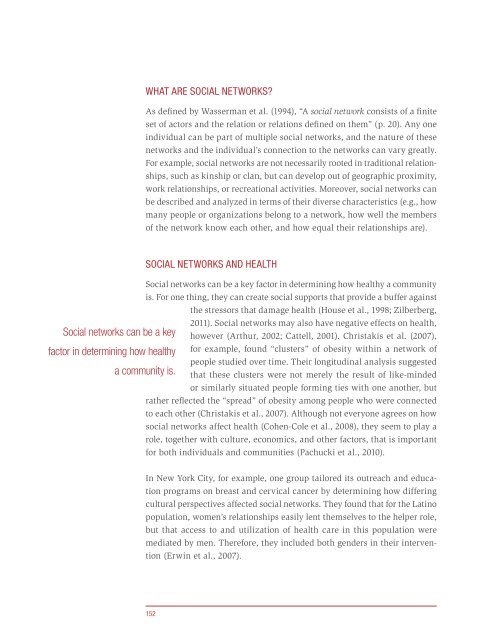Principles of Community Engagement (Second Edition)
Principles of Community Engagement (Second Edition)
Principles of Community Engagement (Second Edition)
You also want an ePaper? Increase the reach of your titles
YUMPU automatically turns print PDFs into web optimized ePapers that Google loves.
Social networks can be a key<br />
factor in determining how healthy<br />
a community is.<br />
WHAT ARE SOCIAL NETWORKS?<br />
As defined by Wasserman et al (1994), “A social network consists <strong>of</strong> a finite<br />
set <strong>of</strong> actors and the relation or relations defined on them” (p 20) Any one<br />
individual can be part <strong>of</strong> multiple social networks, and the nature <strong>of</strong> these<br />
networks and the individual’s connection to the networks can vary greatly<br />
For example, social networks are not necessarily rooted in traditional relationships,<br />
such as kinship or clan, but can develop out <strong>of</strong> geographic proximity,<br />
work relationships, or recreational activities Moreover, social networks can<br />
be described and analyzed in terms <strong>of</strong> their diverse characteristics (e g , how<br />
many people or organizations belong to a network, how well the members<br />
<strong>of</strong> the network know each other, and how equal their relationships are)<br />
SOCIAL NETWORKS AND HEALTH<br />
Social networks can be a key factor in determining how healthy a community<br />
is For one thing, they can create social supports that provide a buffer against<br />
the stressors that damage health (House et al , 1998; Zilberberg,<br />
2011) Social networks may also have negative effects on health,<br />
however (Arthur, 2002; Cattell, 2001) Christakis et al (2007),<br />
for example, found “clusters” <strong>of</strong> obesity within a network <strong>of</strong><br />
people studied over time Their longitudinal analysis suggested<br />
that these clusters were not merely the result <strong>of</strong> like-minded<br />
or similarly situated people forming ties with one another, but<br />
rather reflected the “spread” <strong>of</strong> obesity among people who were connected<br />
to each other (Christakis et al , 2007) Although not everyone agrees on how<br />
social networks affect health (Cohen-Cole et al , 2008), they seem to play a<br />
role, together with culture, economics, and other factors, that is important<br />
for both individuals and communities (Pachucki et al , 2010)<br />
In New York City, for example, one group tailored its outreach and education<br />
programs on breast and cervical cancer by determining how differing<br />
cultural perspectives affected social networks They found that for the Latino<br />
population, women’s relationships easily lent themselves to the helper role,<br />
but that access to and utilization <strong>of</strong> health care in this population were<br />
mediated by men Therefore, they included both genders in their intervention<br />
(Erwin et al , 2007)<br />
152

















